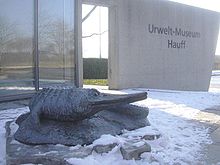Urwelt Museum Hauff
The primeval world museum Hauff in Holzmaden displays fossils from the formation of Posidonienschiefer the Swabian Alb .
history
The museum was established in 1936/37 from the private collection of the taxidermist Bernhard Hauff sen. From 1967 to 1971 it was run by the founder's son, Bernhard Hauff jun. (1912–1990) rebuilt. Its son Rolf Bernhard Hauff has been the director since 1990 .
The Urwelt Museum Hauff has been a Geopoint of the UNESCO Geopark Swabian Alb since 2016 .
exhibition

It houses the best-preserved specimens from the Posidonia schist formation from Holzmaden and Ohmden . The numerous exhibits include ichthyosaurs , plesiosaurs , crocodiles , pterosaurs , fish , sea lilies , ammonites and belemnites .
The most famous exhibits are the world's largest fossilized sea lily colony measuring 18 × 6 m and an ichthyosaur almost four meters long. It is a mother animal with an already born boy. Five other embryos are recognizable in the body.
Extension
In 1993, under the founder's grandson and current director of the museum, Rolf Bernhard Hauff, it was expanded to form the largest private natural history museum in Germany to 1000 m² of exhibition space . Lifelike models of the dinosaurs, films and computer animations of the Jurassic Sea habitat and its underwater world underline the modern museum didactics .
Holzmaden site
The Holzmaden fossil site was declared one of the most important national geotopes in Germany in 2006 by the Academy for Geosciences and Geotechnologies in Hanover . The Academy also named the fossil site as a possible candidate for inclusion in the UNESCO World Heritage Site .
literature
- Rolf Bernhard Hauff: Urwelt Museum Hauff: Life in the Jurassic Sea. Holzmaden, 1997. ISBN 3-9805491-0-0
Web links
Coordinates: 48 ° 38 ′ 7 ″ N , 9 ° 31 ′ 42 ″ E
